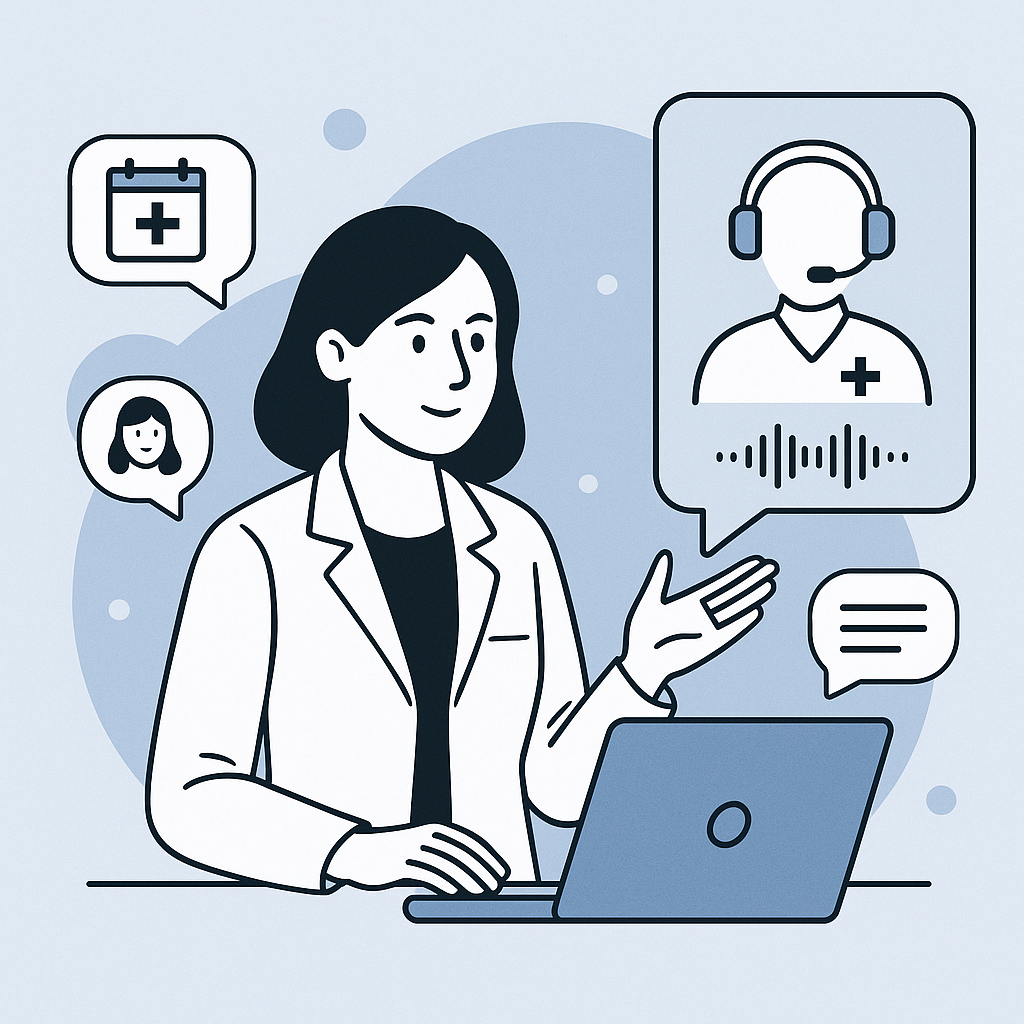When a customer is satisfied, it comes as a very essential bonus. The same applies to the healthcare industry; having a satisfied patient is more likely to follow care plans, return for future visits, and refer others to your facility.
Whether you run a hospital, a small clinic, or any other urgent care setting, improving patient satisfaction directly leads to quality, trust, and better outcomes.
Looking for a patient engagement bot? Fill up the form right away, our team will connect with you shortly!
With rising expectations and instant online reviews, healthcare providers focus on prioritizing the experience at every touchpoint.
Let’s focus and explore 10 practical tips to improve patient satisfaction in various healthcare settings and highlight how AI tools enhance the patient care journey.
How Does Patient Satisfaction Play Its Role in Healthcare?
Patient satisfaction is not only about comfort but also includes clinical outcomes, hospital revenue, and patient loyalty. Customers who are generally satisfied are more likely to follow medical advice, attend appointments, and recommend others as well.
The higher the satisfaction of the patients, will reduce the complaints, the better staff morale, and the enhanced your hospital’s online reputation. In other care models, patient experience scores can influence the reimbursement rates. Whether in outpatient clinics or emergency departments, it is possible to deliver a positive experience that leads to better engagement and trust. In short, we can say that patient satisfaction is not just a metric, but it’s a reflection of the healthcare system’s quality and compassion.
Best Patient Engagement Strategies for Hospitals & Clinics
10 Tips to Improve Patient Satisfaction in Hospitals & Clinics
1. Understand the Setting: Tailored Satisfaction Strategies
Each healthcare setting, whether it’s a hospital, clinic, emergency department, or any urgent care, has unique workflows and patient expectations. For example, a patient always expects to get in-depth care and communication, while a patient in urgent care may value quick service above all.
Understanding these nuances is the first step in crafting an effective patient satisfaction strategy. Tailoring engagement based on care context ensures your efforts resonate. Suppose you're wondering how to improve patient satisfaction in a hospital vs. a clinic. In that case, it starts by customizing care delivery, waiting time management, and communication in line with setting-specific expectations.
2. Streamline Appointment Scheduling
Efficient, user-friendly appointment scheduling is critical to improving patient satisfaction in healthcare. Complicated or outdated systems frustrate patients, leading to delays and no-shows.
Implementing digital scheduling tools, such as AI-powered receptionists like Voiceoc, enables round-the-clock appointment booking, automated reminders, and real-time rescheduling. This not only boosts operational efficiency but also enhances the patient experience by offering flexibility and reducing wait times.
Especially in clinics and hospitals, simplifying the first interaction sets a positive tone for the entire care journey. To truly enhance patient satisfaction, give them control and convenience right from the beginning.
3. Train Staff for Empathy and Communication
No matter the technology you implement, human interaction remains the core of patient satisfaction. Clinical and non-clinical staff must be trained in empathetic communication, active listening, and managing patient emotions.
From front-desk greetings to doctor consultations, every interaction influences the patient’s perception of your care. Patients in emergency departments or urgent care often arrive anxious, and kindness and clear communication can significantly ease their stress.
By investing in emotional intelligence and communication training, hospitals and outpatient clinics can create a more compassionate environment that directly impacts patient trust, compliance, and satisfaction scores.
4. Implement Feedback Loops
One of the best ways to improve patient satisfaction in healthcare is by giving patients a voice. Post-visit feedback, via surveys, calls, or kiosks, provides direct insight into what's working and what needs improvement. Importantly, acting on feedback shows patients their concerns are valued. Clinics and hospitals that establish consistent feedback loops often identify quick wins: shorter wait times, clearer instructions, or better follow-up.
Incorporating tools like Voiceoc’s AI can help collect and analyze feedback at scale. Regularly reviewing and refining based on patient responses demonstrates a commitment to excellence, which strengthens both satisfaction and loyalty.
5. Improve Waiting Room Experience
The waiting room experience is a major factor in shaping patient perceptions. Long, unexplained wait times and uncomfortable environments often cause dissatisfaction, especially in outpatient clinics and urgent care centers. To improve this, offer real-time updates on wait status, provide comfortable seating, and ensure access to Wi-Fi, refreshments, and entertainment.
Ambient lighting, calming visuals, and clean surroundings also contribute positively. Using AI assistants to update patients or manage flow can further reduce perceived wait times. By transforming waiting into a more relaxed and informed experience, healthcare providers can significantly enhance patient satisfaction and comfort.
6. Enhance Digital Touchpoints
Patients today expect digitally empowered care journeys. From online forms and appointment scheduling to digital check-ins and follow-ups, every touchpoint should be intuitive, accessible, and user-friendly. Improving these digital experiences, especially in hospitals and clinics, reduces friction and improves satisfaction.
Voiceoc’s conversational AI helps deliver these services seamlessly, offering real-time support across platforms like WhatsApp or your website. Providing easy access to medical records, educational content, and payment options digitally also contributes to a sense of empowerment. When your healthcare system feels modern and patient-centered, it naturally builds trust and satisfaction.
7. Offer Clear, Timely Communication
Whether it's a diagnosis, treatment plan, or billing issue, patients want information delivered clearly and promptly. Miscommunication or medical jargon can confuse patients and damage trust. To improve patient satisfaction in hospitals or emergency departments, ensure that all staff, especially clinicians, communicate in a patient-friendly manner.
Follow-up instructions should be given both verbally and in writing, with a channel for patients to ask questions. AI assistants like Voiceoc can also help send automated updates and reminders, keeping patients informed post-discharge. Informed patients are more engaged, which leads to better outcomes and higher satisfaction.
8. Focus on Continuity of Care
Continuity plays a key role in improving patient satisfaction across healthcare settings. Patients feel more secure when they experience consistent care, whether through the same doctor, a streamlined EHR system, or proactive follow-ups. This is especially important in emergency and urgent care, where patients often transition to outpatient or specialty care afterward.
AI tools can ensure timely follow-ups, medication reminders, and appointment scheduling without human error or delays. When patients experience seamless transitions between providers and services, they perceive your organization as more competent and caring, greatly enhancing their overall satisfaction.
9. Leverage Technology for Faster Service
Delays in diagnosis, lab results, or prescriptions frustrate patients and lower satisfaction. Embracing technology like AI triage bots, telehealth, and integrated health records enables faster, more efficient service delivery.
For example, using Voiceoc’s AI assistant can speed up patient intake and automate administrative queries, allowing staff to focus on care. In busy settings like emergency departments or hospitals, automation reduces bottlenecks and shortens wait times. Faster doesn’t mean rushed, it means more efficient care pathways. When patients spend less time waiting and more time being cared for, satisfaction naturally increases.
10. Personalize the Experience
One-size-fits-all care no longer works. Today’s patients appreciate a personalized experience, whether it’s remembering their name, offering language preferences, or adjusting communication channels based on their comfort.
Use patient data to customize interactions, AI tools can help by tracking history, preferences, and previous concerns. In clinics and hospitals, personalization can extend to preferences for rooms, dietary restrictions, or follow-up schedules. Even small gestures go a long way in making patients feel seen and valued. Personalization turns medical visits into meaningful relationships, one of the most powerful ways to improve patient satisfaction in healthcare.
How Voiceoc AI Bot Helps to Improve Patient Satisfaction?
Voiceoc’s AI-powered virtual assistant is designed to transform how healthcare providers engage with patients across every touchpoint. From automated appointment scheduling and 24/7 support to post-visit follow-ups and feedback collection, Voiceoc ensures a smooth, patient-friendly journey.
It reduces wait times, streamlines communication, and personalizes interactions across platforms like WhatsApp, web chat, and more. Clinics and hospitals using Voiceoc have seen significant improvements in operational efficiency and patient satisfaction scores. By automating repetitive tasks, it frees up staff to focus on patient care, making Voiceoc not just a tool, but a true partner in delivering quality experiences.
Schedule a 30-minute free consultation with us!
Conclusion
Improving patient satisfaction isn’t a one-time effort; it’s a continuous journey of listening, adapting, and innovating. From scheduling and communication to feedback and follow-up, every step counts.
Whether you're managing a large hospital or a small clinic, these 10 actionable tips can help you enhance patient trust, boost engagement, and deliver exceptional experiences. Technologies like Voiceoc's AI assistant make it easier to personalize care, reduce delays, and support staff. When you put the patient at the center of every decision, satisfaction naturally follows. It's not just about service, it's about care that connects.




.png)







